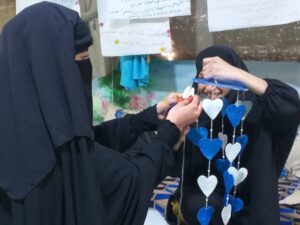Introduction
More than three years after its defeat, ISIS remains a serious threat that requires comprehension and thorough consideration. The attempted escape of ISIS-affiliated prisoners from Ghwiran prison in Hassakeh in January 2022 provided an opportunity to remember that the threat from ISIS remains grim and very real. It is not yet known how many prisoners are on the run, but the death toll has reached close to 500 fighters from ISIS and the Syria Democratic Forces (SDF). This is the largest human loss for the international coalition against ISIS and its local allies since the group was defeated in 2019 in its last stronghold of Baghuz in Deir Ezzor, Syria. Despite all the efforts of the international coalition against ISIS and the SDF, the number of ISIS fighters in Syria remains large, with at least 10,000 believed to be in Syria and Iraq combined, half of which are likely to be in Syria, more densely in its northeast than in the rest of the country. When you combine the roughly 90,000 former ISIS fighters to its prisons, women and children to camps across northeast Syria, the group’s largest concentration in the world is in Syria. This overlap between the ISIS problem and the Syria crisis underscores the depth of the issue.
After 11 years of war, Syria still finds itself at the focus of everything that is alarming and catastrophic in the news. The unstable military situation is a result of the ongoing military operations of Turkey, Iran, the Syrian government, and Israel, even though they are happening at a lower rate. The unstable security situation is a result of the police’s weak control outside cities and the weak borders with Iraq and Jordan. The humanitarian situation is deteriorating due to the inability of the majority of the population to meet their basic needs, even the most essential ones like water, medicine and bread. The economic situation is unspeakable, with the poverty rate reaching more than 80%, unemployment rates reaching more than 40% and the inflation rates increasing at a rate that is hard to follow given the sheer deterioration of the currency’s value. The state of governance is fragmented, authoritarian, and inefficient due to the four different government actors (the Syrian government/regime, the Autonomous Administration in Northeast Syria, the Interim Government in Northwest Syria, and the Salvation Government in Idlib) which do not coordinate with one another and all of which suffer from a lack of resources and competencies, as well as a deteriorating state of service delivery and security. Further to this is the protracted transitional political situation that allows the de facto powers to continue and, without a final political solution, prevents their selective or inclusive integration in power. Can all these crises realistically be resolved before the threat of the extremist group is eliminated?
Before we can set about answering the question, let us take a step back to recognize Syria’s significance for ISIS. Despite all this sharp decline across all levels in Syria, Syria is actually not the most active front for ISIS. In the lead is actually Afghanistan followed by Africa (Mali, Nigeria, Uganda, Democratic Congo and others), followed by Iraq and only then Syria. After Syria, the list continues with the Sinai in Egypt and Israel’s Negev desert, as well as Yemen and Libya. The circumstances of these countries and regions resemble Syria’s in terms of the collapse of the state or its failure in terms of economic, political, and security aspects. The success in reducing ISIS activities in Syria may be attributed to the international coalition as well as the SDF and their sacrifices. The security solution seems to work, but it is not sustainable. Therefore, we should not overlook the importance of continuing efforts to improve the security, economic and political situation in all of Syria, and in the northeast in particular, to ensure that the threat of ISIS’s return vanishes.
This paper aims to clarify the international importance of Syria to ISIS, to detail the security, economic, and political contexts of the organization in northeast Syria, to address the challenges facing those who are fighting the organization, such as the Global Coalition against ISIS, the autonomous-administration, and the SDF. Finally, it will discuss the methods available to deal with urgent challenges. To avoid generalization, the paper will try to focus on Deir Ezzor as an example which focuses on all security, economic, and political challenges. The focus on Deir Ezzor does not mean ignoring other or less important areas; on the contrary, there are many similarities between Deir Ezzor and other cities in northeast, west, central, and southern Syria. Geographic focus will help clarify the concepts and will enable detailed comparison with future research in other regions. The paper begins with the premise that security solutions to deal with terrorism are important, but they do not work alone without understanding and improving broader economic, governmental, and political contexts. The research relied on a combination of office research and field interviews with independent experts and officials, not only from northeast Syria but also from the Global Coalition against ISIS.
Conclusion
The previous section represented an attempt to answer the research question of whether the problem of ISIS can be solved without solving the problem of Syria? Syria is a unique counterterrorism model, where a security solution is clearly the most effective – and perhaps the only – way to deal with ISIS and reduce the risk of ISIS at the moment, but it is also not enough of an answer. A comparison of ISIS’s modest performance in Syria compared to other regions where it is globally active shows the importance of the US-led Global Coalition’s efforts to end the restoration of its lost glory. Syria shares the same features of state collapse as Afghanistan and many African countries – deteriorating services, absent security, long porous borders, and disputed and shaky legitimacy – yet ISIS does less well in Syria than these other regions with similar characteristics. But Syria will remain important for ISIS for many symbolic and practical reasons, and its attempts to strengthen its influence there will continue despite all international and domestic efforts. This means that there can be no room for complacency in the fight against the group across security or military fields. There must also be a greater effort to reduce its appeal to young people and the financial resources at its disposal which allow it to continue to spread. This can happen after increasing the legitimacy of its political structure, strengthening the capacities of its service institutions, and striving to reach a comprehensive political solution to the conflict in Syria despite the many challenges faced.
There are several scenarios for the political future of the region that will significantly impact the ability to fight ISIS. The first and most likely is the continued presence of the Global Coalition forces, as well as the prolongation of the current state of fragmentation. While this scenario certainly provides an ISIS-deterrence force, it does not guarantee the emergence of institutions with legitimate and improved capacity to provide services and security on an equal footing. The second scenario is the departure of the Global Coalition forces, and the Syrian regime’s recapture of northeast Syria and perhaps parts of northwest Syria in the event of an agreement with Turkey and its total or partial departure. This scenario may help shape a better political horizon, but it threatens cross-border chaos with the loss of military deterrence and policing of northeast Syria along its extended borders with Iraq and Jordan.
It is difficult to separate Syria’s problems as an active conflict from its problem of ISIS activity and its global effects. In the absence of a political solution and the lack of basic security and infrastructure, it will be difficult for international donors to focus on improving the economic situation in northeast Syria. Many fear the angry reactions that are expected from Turkey, the Syrian government, Iran and Russia. Nevertheless, donors should continue to support efforts to improve institutional representation of community diversity, strengthen their capacity to deliver services and collect revenue, and support community reconciliation.
But if there is a choice in terms of the anti-ISIS policy, the risks posed by prisons and camps – the group’s epicenter for its activities in Syria – must be reduced. Reducing the number of Iraqi and Syrian camp residents – who make up more than half of the camps’ population – would be a major accomplishment and would greatly reduce risk. This would then be followed by a safe and dignified release for children and young people, who represent more than 70 per cent of the camp population. Leaving these children in the camps without education, health care and the opportunity to explore better alternatives to their future means that ISIS will become the only remaining option to accept them and offer them a life direction after all other doors have been closed to them.


